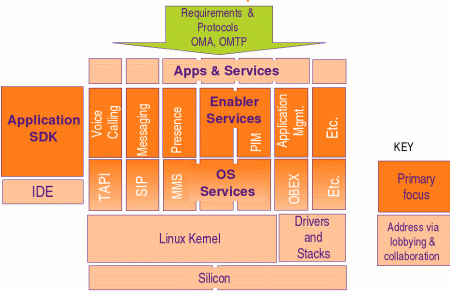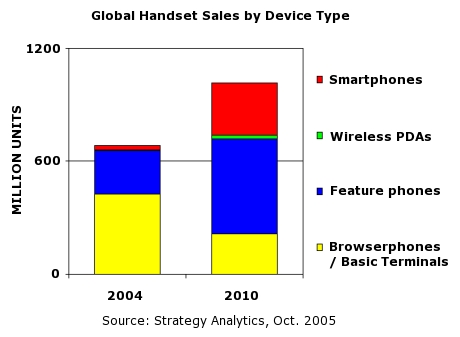Consortium tackles Linux mobile phone standards
Nov 14, 2005 — by LinuxDevices Staff — from the LinuxDevices Archive — viewsEleven companies today launched a cross-industry consortium chartered to turn embedded Linux into a plug-and-play mobile phone platform comparable to Microsoft's Windows Mobile Smartphone OS, but with greater flexibility and lower costs. The Linux Phone Standards Forum (LiPS) intends to help make Linux a more standardized, interoperable mobile phone OS.
Compared to commercial mobile phone stacks from Microsoft and Symbian, embedded Linux is generally considered to be more flexible, but less complete. In contrast Microsoft and Symbian have integrated off-the-shelf mobile phone stacks including kernel, libraries, multimedia and communications protocols, management and security utilities, PIM (personal information management) applications, and even graphical branding elements. Additionally, both Windows Mobile and Symbian enjoy healthy third-party software ecosystems.
Linux mobile phones, on the other hand, provide greater branding and differentiation opportunities, and avoid vendor lock-in — high priorities among mobile carriers and phone vendors. However, the use of Linux on mobile phones currently requires carriers and device vendors to assemble and test their own phone software stacks.
To address this shortcoming, embedded Linux software vendors such Trolltech, MontaVista, PalmSource, and Wind River have been attempting to assemble more complete, off-the-shelf mobile phone stacks on an ad hoc basis. But due to the diversity of choices available for graphics environments, C libraries, PIM and utility apps, media handlers, service provisioning schemes, etc., the resulting Linux phone stacks lack interoperability. This, in turn, has stymied the emergence of a third-party software and services ecosystem supporting Linux mobile phones.
(An illustration comparing Symbian and Windows Mobile to one Linux mobile phone approach, MontaVista's Mobilinux, appears here. The portions of the mobile phone OS stack that are constrained by each alternative appear within the shaded areas surrounded by solid lines.)
According to LiPS, this tendency toward fragmentation can best be avoided through adherence to open standards created by industry groups.
In particular, LiPS feels that cooperation from mobile carriers and phone vendors will be key to defining the requirements for a standard, interoperable, Linux mobile phone platform. For this reason, LiPS has initially focused on recruiting mobile carriers as LiPS members, according to PalmSource lead scientist John Ostrem and Jaluna CTO Michel Gien — both of whose companies are founding members of LiPS — who spoke with LinuxDevices.com about LiPS's mission and goals.
LiPS mission
LiPS says its primary focus will be “to define standards for the aspects of Linux that directly enable the deployment, development, and interoperability of applications and end user services.”
The group's standardization efforts aim to deliver:
- Standardized APIs (application programming interfaces) that define the layers of Linux that directly influence applications and services running on a phone
- Standards for software development kits (SDKs) that allow developers to easily take advantage of LiPS APIs to develop their products
- A testing methodology that will be used to certify LiPS-compliant implementations

Scope of LiPS standardization efforts — the dark orange shading shows main areas of focus
(Source: LiPS)
In meeting these objectives, the group plans to work closely with the OMTP, an industry group that defines functional requirements for mobile phones, to speed delivery of OMTP-compliant Linux-based mobile phones. OMTP was established in June of 2004 by Orange, NTT DoCoMo, mmO2, Smart Communications, Telecom Italia Mobile, Telefonica Moviles, T-Mobile, and Vodafone.
Initially, LiPS plans to create profiles for several types of mobile phones, including smartphones, feature phones, converged, and fixed-line devices. Each profile will define a set of required application and service APIs and API behaviors. Each profile will also include a testing procedure, and LiPS will offer certification services “so vendors can say their phones are LiPS-compliant,” Ostrem says.
Additionally, LiPS may address requirements for standardized application development tools or tool components, Ostrem says, to help streamline and standardize third-party application development.
LiPS will also try to facilitate standardization of user interfaces, messaging protocols such as MMS and SMS, device management and security functions, and application installers. Gien said, “We're looking at services and enablers needed to write native applications. They need to have some kind of framework to get installed, to get security, to get upgraded, all these kinds of functions. Application management functions.”
When possible, existing open source software will be leveraged, although Ostrem and Gien also expect LiPS to create some new APIs and write software to fill some gaps.
In general, the fundamental LiPS goal will be to define a platform that can be easily customized, so that operators and phone vendors can differentiate their products, but which provides all of the services and applications for a complete mobile phone stack.
“The hope is to try to reduce fragmentation [of the mobile phone Linux stack] by going through this process — that's the whole purpose of doing this,” Ostrem said.
Overlapping standards
Another industry group, the powerful OSDL (open source development labs), launched its own Linux phone software standards effort last month, the Mobile Linux Initiative (MLI). Whereas MLI will focus mainly on standard embedded Linux kernel-level issues and services, “like improved boot time and power management,” according to Ostrem, LiPS will focus higher up in the stack, “on standards than enable key applications and services to be deployed with a great deal of interoperability across the variety of phones.”
“LiPS has already been talking with the OSDL, and we think we'll be able to cooperate with them quite well,” Ostrem said. “The ultimate goal, of course, is to try to create a complete standard platform, from the kernel all the way up through the application and service layers. And by combining [our efforts with those of] the OSDL, we can get something quite close to that.”
Ostrem and Gien admit that some areas of overlap exist, with regard to operating system services, but say the two groups hope to cooperate. Ostrem stated, “We hope to work with them to make sure that [the kernel extensions] they're developing will meet the needs of our layer, too,” Ostrem said.
Gien added, “We will be acting as a requirements body for OSDL's Linux kernel improvements, and be expecting from them stuff that supports our OS service requirements, management services, and enabling services, and so forth.”
“We will try to specify some requirements for the Linux kernel that OSDL and others will be creating, so as to make sure it meets our requirements for performance, power consumption, things like that, that are really needed to make a complete, viable phone,” Ostrem added.
Ostrem confirmed that LiPS is also talking with CELF (Consumer Electronics Linux Forum).
“Not only do we want to reduce the fragmentation of Linux, but we also want to reduce the fragmentation of the standardization groups around Linux,” Ostrem said. “So we're all trying to talk and find a way that we can all cooperate together and work towards one platform and one solution — that's an ongoing effort.”
“We're all interested in promoting Linux as an alternative to Microsoft and Symbian,” Ostrem added.
Near-term goals
LiPS plans to start by creating a profile for low-end phones, before working up to profiles for higher-end phones with a greater number of attached peripherals. Gien stated, “We're starting with low-end phones, asking, 'What is the set of minimum functions for the Linux kernel to go into a phone?' ”
He adds, “It'll be an incremental process. We will try to define a set of profiles that can represent a class of phones. We are trying to minimize the number of profiles, and group the set of functions so they can go into each category.”
Initial membership
Founding members of LiPS include: ARM Ltd., Cellon, Esmertec, France Telecom/Orange, FSMLabs, Huawei, Jaluna, MIZI Research, MontaVista, Open Plug, and PalmSource. Additionally, membership is growing “on a day-to-day basis,” according to Ostrem.
According to Gien, France's Orange Telecom is the key driver of LiPS, and the organization is focusing initially on “getting major operators in place.” Gien says operators in Europe and Asia have been especially supportive, with several in “advanced stages” of signing membership agreements.
Notably absent from LiPS's founding members is embedded Linux OS vendor Wind River (which recently announced its consumer electronics Linux product), application-level vendors such as Trolltech and Opera, and device vendors such as Motorola and Nokia. Ostrem and Gien declined to comment on which of these vendors are currently considering LiPS membership.
In general, Gien said, LiPS hopes to gain additional commercial members from the embedded Linux OS, tools, and applications communities, including vendors of application security and management software.
Analysis
Due to the wide variety of open source software that is available for Linux, creating a standardized Linux implementation would likely involve some tough trade-offs, depending on how far up the stack LiPS plans to venture. For example, Trolltech and PalmSource both offer user interface and application frameworks suitable for mobile phones. Consequently, choosing which application environment to support in a particular profile could lead to member entrenchment and ossification.
Gien and Ostrem say that such decisions may need to be made, however, because creating a more coherent mobile phone OS is ultimately in all members' best interests. “The certification process will be worked out among member companies, and the hope is to reduce fragmentation. If PalmSource wants to call its products LiPS-compliant, it will have to meet the same requirements as anyone else,” Ostrem said.
One key advantage of Linux is that it can address a wider range of mobile phone platforms than just the high-end devices targeted by the Microsoft and Symbian smartphone offerings. In particular, Strategy Analytics has projected that mid-range “feature-phones” will be the largest mobile phone category by 2010. Feature-phones are described as advanced handsets offering applications such as digital camera functions, video streaming, gaming, multimedia, and messaging.

Ultimately, however, the success of LiPS will hinge on its gaining support from mobile carriers, who are most responsible for phone software platform selection. If LiPS does succeed in standardizing the Linux mobile phone platform, Microsoft and Symbian will lose one of their most persuasive selling points — namely, the claim that Linux does not offer an off-the-shelf mobile phone platform.
“In the end [the carriers] don't care about the OS — what they care about is having one application anvironment that runs on all their phones,” Gien emphasized.
“Some of us see the potential of having one operating system run a whole range of phones — not just the high-end phones — from the high-end phone down to at least the middle layer phones, and I think operators see that also as a potentially big advantage. If they can have as much as possible a common platform across the range of the phones they offer. And I think there is potential with Linux to do that to a great degree,” added Ostrem.
This article was originally published on LinuxDevices.com and has been donated to the open source community by QuinStreet Inc. Please visit LinuxToday.com for up-to-date news and articles about Linux and open source.